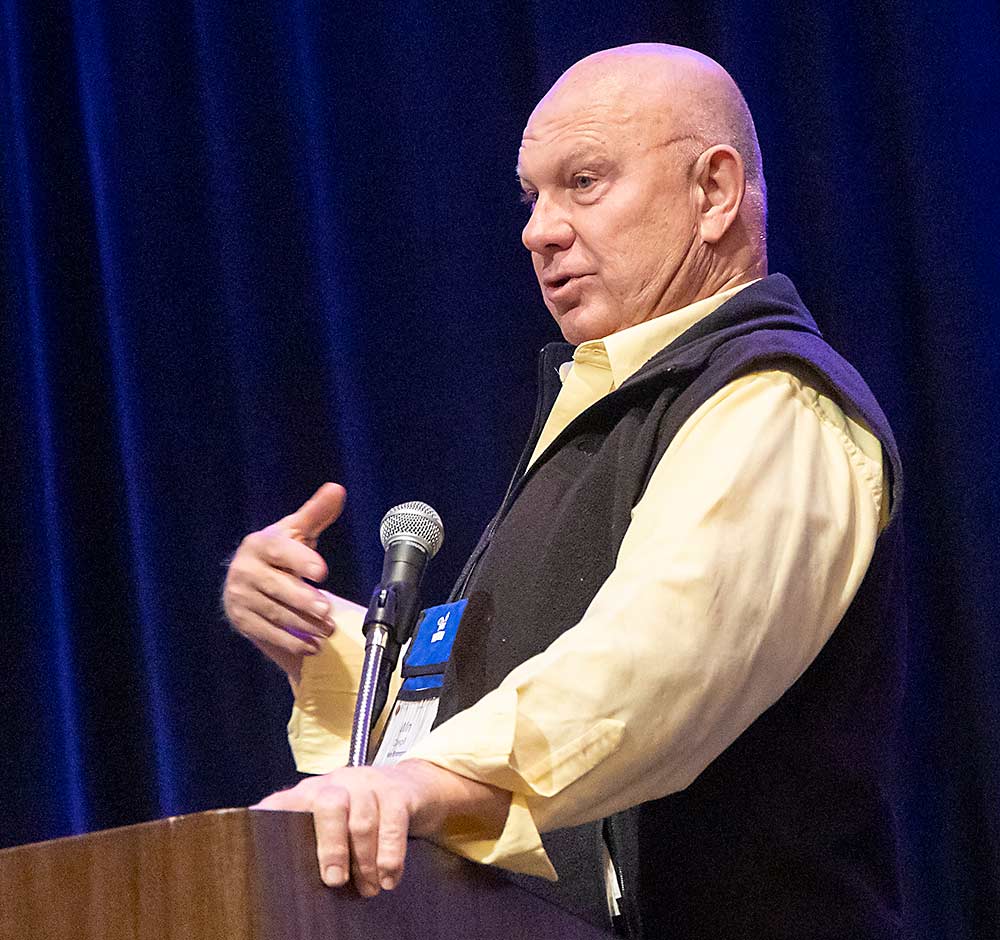
How can a grower tell the difference between an effective product and snake oil?
Horticultural consultant and retired Rutgers University professor Win Cowgill and a panel of growers explored that question during the International Fruit Tree Association’s 65th annual conference in Hershey, Pennsylvania, in February. The panelists gave examples of plant growth regulators, fertilizers and other products they’ve tried and discussed how well they worked. Their consensus: If a product works, they use it again. And if it keeps working, it becomes a regular part of their program.
Cowgill said his definition of “snake oil” would include a product only backed by customer testimonials and not by third-party, replicated research results.
“If a developer is not willing to invest dollars to test their own product, then it might be a snake oil,” Cowgill said.
But product performance can vary, and even plant growth regulators backed by investment and replicated research don’t always work perfectly. That doesn’t make them snake oils. It just means there’s more to learn, he said.
Even with all the precision thinning tools available to growers today, including fruitlet measuring and computer-based weather models, “PGRs and weather will surprise us one out of five years, at least,” Cowgill said.
“It is the amount of work, the quality of the work, and multiple-year experiences of researchers, consultants and growers that let us figure out how to use any of these products and, most importantly, make them work for us as uniformly as possible,” he said.
As the owner of a farm supply company, New Hampshire fruit and vegetable grower Trevor Hardy is constantly approached by sales representatives saying, “I have the best thing since sliced bread,” he said.
Hardy usually tells them to drop off some samples with him and other growers he knows, so they can try it for themselves. He gave an example of a product he’s seen work well: He used the Omex foliar fertilizers Calcium Platinum and Calcium Gold over the past two years, and they’ve done a good job reducing bitter pit in Honeycrisp. The sprayed Honeycrisp trees have no yellow spots on their leaves and better-looking fruit than the untreated trees, he said.
Hardy has not conducted a statistical analysis of the fertilizers’ costs and benefits, but he can see the difference.
“The whole dang Honeycrisp tree is green,” he said. “That jumps out at you.”
Hardy also highlighted a 16-4-13 water-soluble fertilizer from Plant Marvel Laboratories, which he uses to fertigate his trees for eight to 10 weeks in spring. He feeds the fertilizer once a week through a drip system at 12.5 to 25 pounds per acre, depending on rootstock development. The slow, consistent dose aids tree growth, he said.
Hardy gets more consistent results delivering nutrients via drip irrigation and uses foliar applications as a short-term backup. Irrigation maintenance is essential, he said.
“We buy the best sprayers, we buy good fertilizer spreaders, but the one thing farmers always go cheap on is drip tubing,” Hardy said. “Make sure your irrigation system is doing what it’s supposed to do to deliver nutrients to the crop.”
Massachusetts grower Mo Tougas said Stimplex, a seaweed-based biostimulant from Ilex EnviroSciences, helps his cherries set a better crop.
Tougas uses Valent’s MaxCel (6-benzyladenine) and Promalin (6-benzyladenine and gibberellins) plant growth regulators for thinning and to promote branching, respectively. Fine Americas’ Blush 2X (prohydrojasmon) has done a good job reddening his apples, he said.
Tougas said he learns about products in trade magazines, from extension educators or consultants and from sales reps.
“I’d like to tell you that we run unbiased trials, but generally if we see a difference on the trees, or at least think we do, then we continue their use,” Tougas said.
Maryland grower Bob Black said Endurance PGR (choline chloride and gamma-aminobutyric acid) from Loveland Products improved fruit set in his Magness and Seckel pears when he applied it during bloom in 2021. Both varieties had big crops — Seckel his biggest ever.
Black applied Rx Platinum, a Redox phosphate and potassium fertilizer, for frost protection on his Japanese plums in spring 2021. He applied it to trees that had over 40 percent of their blossoms open. The treated trees had a higher survival rate, he said. •
—by Matt Milkovich







Leave A Comment